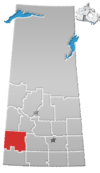|
Rural Municipality of Big Stick No. 141
The Rural Municipality of Big Stick No. 141 (2016 population: 136) is a rural municipality (RM) in the Canadian province of Saskatchewan within Census Division No. 8 and SARM Division No. 3. It is located in southwest portion of the province. HistoryThe RM of Big Stick No. 141 incorporated as a rural municipality on December 11, 1911.[2] The RM takes its name from the alkali Bigstick Lake within its boundaries, which was named after the Big Stick Trail between Maple Creek and the South Saskatchewan River – notable for a large, solitary tree along its route. A Big Stick Lake post office also operated at SE-27-14-26-W3 from 1911 to 1925.[5] GeographyCommunities and localitiesThe following urban municipalities are surrounded by the RM. DemographicsIn the 2021 Census of Population conducted by Statistics Canada, the RM of Big Stick No. 141 had a population of 148 living in 60 of its 68 total private dwellings, a change of 8.8% from its 2016 population of 136. With a land area of 831.87 km2 (321.19 sq mi), it had a population density of 0.2/km2 (0.5/sq mi) in 2021.[8] In the 2016 Census of Population, the RM of Big Stick No. 141 recorded a population of 136 living in 57 of its 74 total private dwellings, a -8.1% change from its 2011 population of 148. With a land area of 821.4 km2 (317.1 sq mi), it had a population density of 0.2/km2 (0.4/sq mi) in 2016.[4] GovernmentThe RM of Big Stick No. 141 is governed by an elected municipal council and an appointed administrator that meets on the first Wednesday of every month.[3] The reeve of the RM is Edward Feil while its administrator is Melinda Hammer.[3] The RM's office is located in Golden Prairie.[3] References
|
||||||||||||||||||||||||||||||||||||||||||||||||||||||


